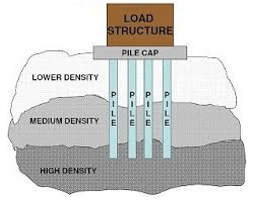The foundation in its widest sense can be said to be expanded base of a wall or a column in addition to the ground or sub-soil, which the building stands is the natural foundation, and the expanded base which is constructed with concrete or masonry materials like rocks, stone, or bricks is called the artificial foundation. However, when the word ‘foundation’ is used ordinarily, it means artificial foundation. In a swampy and waterlogged area, foundation also embraces the long concrete poles driven, or concrete cast into bored holes for purposes of carrying the structure above it.
Function of Foundation
The foundation, acting as a large flat-heeled shoe worn by the building, bears the total weight of the building and ensures that the weight is evenly distributed over the surface area of the foundation in such a manner that eliminate unequal settlement.
Types of Foundation
There are five major types of foundation:

2. Raft foundation: This is a continuous concrete base under the whole building. The concrete here in reinforced with iron bars. This type of foundation is usually used where the bearing capacity of the soil is very low e.g. clay soil, marshy or water logged area

3. Pad foundation: This is an isolated concrete base under the columns. The area of the foundation will depend on the load it is going to carry. The depths of the reinforcement are supplied by the structural engineer.


5. Stepped foundation: This is a strip foundation constructed on a sloppy ground. Also where the nature of the soil in a building site is not the same, for instance, if some parts of the ground is sandy and other part is clayey, stepped foundation will be incorporated

Assessment
Briefly explain the types of foundation
Read our disclaimer.
AD: Take Free online baptism course: Preachi.com 